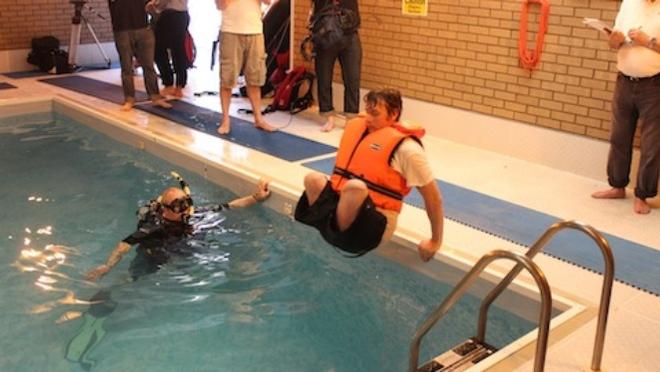What do you expect from your lifejacket?
by RYA on 18 Jun 2015

lifejackets test RYA
We all have some preconceived ideas about what a lifejacket is supposed to do. For able-bodied sailors, most have the advantage of being able to jump in the water to test their lifejackets themselves. For those with disabilities that process can be more challenging.
Led by Richard Falk, RYA Training Manager and Chief Examiner, we set out to assist a group of disabled boaters put a wide variety of lifejackets to the test.
Richard reports......
We were originally approached in 2013 by several disabled boaters who were very keen to know more about how their lifejackets would work for them and also to be able to trial different types of lifejackets.
From this catalyst, the idea evolved for a full blown lifejacket testing day involving 10 or so boaters with varying forms of disability and most of the major UK lifejacket manufacturers.
The testing was far from scientific and none of the findings were new, but for many it was their first experience of actually being in the water in a lifejacket.
Here is a summary of what we found.
Despite the day being conducted in a heated pool, a controlled environment with safety swimmers and divers and with all participants well prepared to enter the water a number of them found the reality of being supported by a lifejacket very unnerving and claustrophobic and exhibited some degree of panic.
Lifejackets with no thigh or crutch straps were at best useless and in some cases dangerous.
Almost without exception the expectation of the test subjects was that the lifejackets being tested would return them to an upright position, regardless of how they entered the water. This expectation in many cases was not met!
Clothing, wet weather gear, boots and, in particular, dry suits had varying degrees of impact on the ability of the lifejacket to turn the casualty into a face-up position.
Larger volume lifejackets on casualties with a smaller body type were less effective at returning the casualty to a face-up position if they entered the water-front first.
Fixed buoyancy or static lifejackets and buoyancy aids were not effective in righting a casualty to a face-up position.
Buoyancy aids (as opposed to lifejackets) worked well for conscious casualties but tended to float unconscious casualties or those with less mobility face down.
If properly fitted and adjusted all lifejackets tested held the casualty well supported with good stability and buoyancy regardless of body shape, clothing or disability, once they were actually in a face-up position.
Key observations
There was an almost blind faith amongst many of our test subjects that the lifejacket would turn them into a face-up position regardless of any variable they may encounter.
Whilst lifejackets are designed with this aspiration in mind it is not a requirement for them to do so in order for them to meet the various standards requirements. The realisation for most subjects that the lifejacket on its own may not be enough to right them was a real eye-opener.
We found that buoyancy in legs - caused by muscle wastage, lack of bone density or sealed feet in drysuits for example - made it much more difficult for the lifejacket to turn the casualty face up.
Our range of test subjects covered a multitude of disabilities ranging from quadriplegia with virtually no ability to manoeuvre themselves through to those who were able-bodied. Single amputees, double amputees, recovering stroke patients and the visually impaired all involved themselves fully to put the various makes and models of lifejackets to the test.
All of the day's participants were regular boaters across a variety of different craft and many were also involved in assisting disabled boaters through various RYA Sailability groups.
For those with very limited mobility it became absolutely clear that there was a need for them to have a dedicated support boat with multiple helpers very close to hand in the event that they ended up in the water.
Whilst their automatic lifejackets provided buoyancy in an instant, whether or not they ended up face up or down in the water depended almost entirely on how they entered the water rather than the inflation action of their lifejacket.
There was a need for someone to be in the water and providing assistance almost immediately after the test subject entered the water.
One overriding feature of the day was that the “lessons learned” could be applied equally to both disabled and able bodied boaters.
It emphasized the huge advantage not only in being familiar with your own lifejacket and its operation but also in ensuring that it suited your own body shape and type.
There had been some suggestion from certain quarters prior to this event that perhaps some more specialised and adapted form of lifejacket might be required for some disabled boaters.
The results of the day really highlighted that with the great range of lifejackets on the market, the most important factor is actually about ensuring the lifejacket you use is well suited to you, is properly fitted and secured and that you are familiar with its operation.
Acknowledgements
Our thanks go to the more than 30 people who helped put the day together, in particular to our nine test subjects who each had up to 10 entries into the water in a variety of different lifejackets – the heated pool didn’t feel that warm by the end of a very long day!
Our thanks also to UKSA in Cowes for the use of their pool and to the following lifejacket manufacturers and distributers who contributed openly and generously to the event - Baltic Safety, Crewsaver, Ocean Safety, Parmaris, Spinlock and Viking.
A final thanks also to the many RYA Sailability volunteers and staff who worked hard to make the day possible and to support our “guinea pigs”.
If you want to link to this article then please use this URL: www.sailworldcruising.com/135585